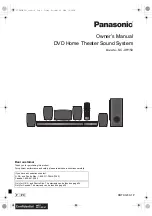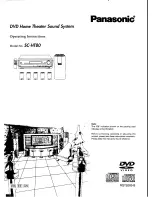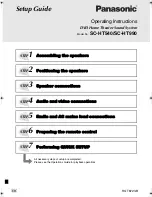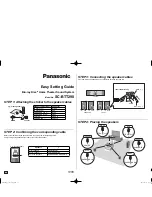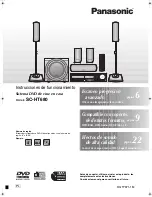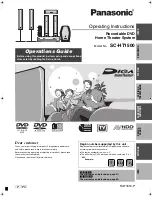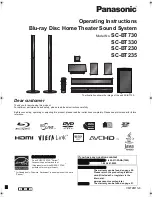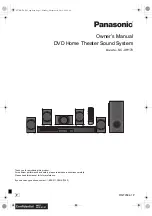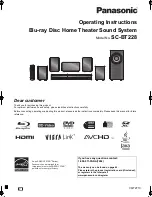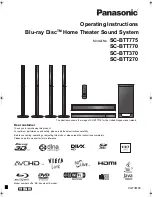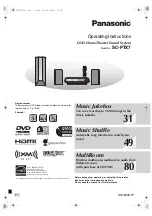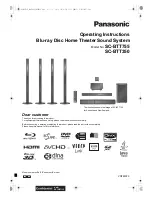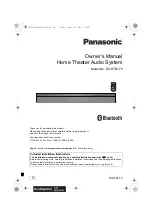
MAINTENANCE/INSPECTION PROCEDURE
4-20
The recording density of a VCR(VCP) is much higher than
that of an audio tape recorder. VCR(VCP) components must
be very precise, at tolerances of 1/1000mm, to ensure com-
patiblity with other VCRs. If any of these components are
worn or dirty, the symptoms will be the same as if the part is
defective. To ensure a good picture, periodic inspection and
maintenance, including replacement of worn out parts and
lubrication, is necessary.
Schedules for maintenance and inspection are not fixed
because they vary greatly according to the way in which the
customer uses the VCR(VCP), and the environment in which
the VCR(VCP) is used.
But, in general home use, a good picture will be maintained
if inspection and maintenance is made every 1,000 hours.
The table below shows the relation between time used and
inspection period.
Table 1
(1) Grease : Kanto G-311G (Blue) or equivalent
(2) Isopropyl Alcohol or equivalent
(3) Cleaning Patches
(4) Grease : Kanto G-381(Yellow)
(1) Cleaning video head
First use a cleaning tape. If the dirt on the head is too
stubborn to remove by tape, use the cleaning patch. Coat
the cleaning patch with Isopropyl Alcohol. Touch the
cleaning patch to the head tip and gently turn the
head(rotating cylinder) right and left.
(Do not move the cleaning patch vertically. Make sure
that only the buckskin on the cleaning patch comes into
contact with the head. Otherwise, the head may be dam-
aged.)
Thoroughly dry the head. Then run the test tape. If lso-
propyl Alcohol remains on the video head, the tape may
be damaged when it comes into contact with the head
surface.
(2) Clean the tape transport system and drive system, etc,
by wiping with a cleaning patch wetted with Isporopyl
Alcohol.
1
It is the tape transport system which comes into contact
with the running tape. The drive system consists of those
parts which moves the tape.
2
Make sure that during cleaning you do not touch the tape
transport system with the tip of a screw driver and no that
force is that would cause deforming or damage applied to
the system.
2. Required Maintenance
3. Scheduled Maintenance
5) Maintenance Procedure
5-1) Cleaning
NOTES:
About 1
year
One hour
Two hours
Three hours
When
inspection is
necessary
Average
hours used
per day
About 18
months
About 3
years
4. Supplies Required for Inspection and
Maintence
Fig. C-9-4
Drum
(Rotating Cylinder)
Head Tip
Coat With Isopropyl Alcohol
Touch this section of cleaning
patch to the head tip and gently
turn the Drum (Rotating Cylinder)
Cleaning Patch
Summary of Contents for D35
Page 11: ...2 5 3 Speaker Section DTE 550TE Speaker Section Part List 850 852 851A 851 853 854 857 858...
Page 34: ......
Page 49: ...3 92 INTERNAL BLOCK DIAGRAM OF ICs CS8415A...
Page 50: ......
Page 59: ...3 38 3 39 2 POWER SMPS CIRCUIT DIAGRAM 2...
Page 60: ...3 40 3 41 3 TU IF ACSS A2 CIRCUIT DIAGRAM EE MODE VIDEO TU MODE AUDIO...
Page 66: ...3 52 3 53 PRINTED CIRCUIT DIAGRAMS 1 MAIN P C BOARD LOCATION GUIDE...
Page 67: ...3 54 3 55 2 KEY RIGHT P C BOARD LOCATION GUIDE 3 KEY LEFT P C BOARD LOCATION GUIDE...
Page 68: ......
Page 71: ...3 72 3 73 3 MPEG CIRCUIT DIAGRAM Optical Coaxial out CVBS Y Pb Pr Componet Y C S VHS WAVEFORM...
Page 74: ...3 78 3 79 6 JACK CIRCUIT DIAGRAM...
Page 78: ...3 86 3 87 PRINTED CIRCUIT DIAGRAMS 1 MAIN P C BOARD TOP VIEW LOCATION GUIDE...
Page 79: ...3 88 3 89 2 MAIN P C BOARD BOTTOM VIEW LOCATION GUIDE...
Page 80: ......
Page 83: ...3 97 3 98 CIRCUIT DIAGRAMS 1 AMP CIRCUIT DIAGRAMS...
Page 84: ...2 DSP DIGITAL AUDIO PROCESSING CIRCUIT DIAGRAMS 3 99 3 100...
Page 85: ...3 101 3 102 3 COM CIRCUIT DIAGRAMS...
Page 86: ...PRINTED CIRCUIT DIAGRAMS 1 MAIN P C BOARD SOLDER SIDE LOCATION GUIDE 3 103 3 104...
Page 87: ...3 105 3 106 2 MAIN P C BOARD LOCATION GUIDE...
Page 88: ......
Page 111: ...4 22 GEAR F R GEAR AY P2 P3 Lever F R Base Tension Boss CAM...
Page 120: ...MEMO...
Page 156: ......































